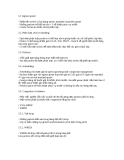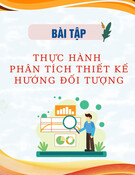
Sorting (cont.)

Quicksort
•For partitioning we need to choose a
value a. (simply select a = x[0])
•During a partition process: pairwise
exchanges of elements.
Quicksort
•A “partition-exchange” sorting method:
Partition an original array into:
(1) a subarray of small elements
(2) a single value in-between (1) and (3)
(3) a subarray of large elements
Then partition (1) and (3) independently
using the same method.
Eg. 25 10 57 48 37 12 92 86 33
=> 12 10 25 48 37 57 92 86 33
Eg. 25 10 57 48 37 12 92 86 33
=> 12 10 25 48 37 57 92 86 33
x[0..N-1]
a
A possible arrangement:
simply use first element (ie.
25)
for partitioning

Original: 25 10 57 48 37 12 92 86 33
Partitioning: Select a = 25
Use 2 indices:
down up
25 10 57 48 37 12 92 86 33
down up
25 10 12 48 37 57 92 86 33
up down
25 10 12 48 37 57 92 86 33
12 10 25 48 37 57 92 86 33
Move down towards up until x[down]>25
Move up towards down until x[up]<=25 (*)
Swap
Continue repeat (*) until up
crosses down (ie. down >= up)
up is at right-most of smaller
partition, so swap a with x[up]
Quicksort
down up
25 10 57 48 37 12 92 86 33

Quicksort
25 10 57 48 37 12 92 86 33
12 10 25 48 37 57 92 86 33
10 12 25 33 37 48 92 86 57
12 10 25 48 37 57 92 86 33
=>
4810 12 25 33 37 57 86 92
10 12 25 33 37 48 92 86 57
=>
48 92
33 3710 12 25 57 86
=> 48
37 9257 86
10 12 25 33
924833 3710 12 25 57 86
=>
=> 924833 3710 12 25 57 86 Sorted
Original

Quicksort
void quick_sort(int x[ ], int idLeftmost, int idRightmost)
/* Sort x[idLeftmost].. x[idRightmost] into ascending numerical order. */
{int j;
if (idLeftmost >= idRightmost)
return; /* array is sorted or empty*/
partition(x, idLeftmost, idRightmost, &j);
/* partition the elements of the subarray such that one of the elements
(possibly x[idLeftmost]) is now at x[j] (j is an output parameter) and
1) x[i] <= x[j] for idLeftmost <= i < j
2) x[i] >= x[j] for j<i<= idRightmost
x[j] is now at its final position */
quick_sort(x, idLeftmost, j-1);
/* recursively sort the subarray between positions idLeftmost and j-1 */
quick_sort(x, j+1, idRightmost);
/* recursively sort the subarray between positions j+1 and idRightmost */
}








![Nhu cầu về QoS và các mô hình QoS [chuẩn nhất]](https://cdn.tailieu.vn/images/document/thumbnail/2011/20110721/congnghe08/135x160/bai_1_bai_viet_gioi_thieu_ve_chat_luong_dich_vu_trong_mang_campus_7901.jpg)


![Tài liệu ôn tập môn Lập trình web 1 [mới nhất/chuẩn nhất]](https://cdn.tailieu.vn/images/document/thumbnail/2025/20251208/hongqua8@gmail.com/135x160/8251765185573.jpg)









![Hệ thống quản lý cửa hàng bán thức ăn nhanh: Bài tập lớn [chuẩn nhất]](https://cdn.tailieu.vn/images/document/thumbnail/2025/20251112/nguyenhuan6724@gmail.com/135x160/54361762936114.jpg)
![Bộ câu hỏi trắc nghiệm Nhập môn Công nghệ phần mềm [mới nhất]](https://cdn.tailieu.vn/images/document/thumbnail/2025/20251111/nguyenhoangkhang07207@gmail.com/135x160/20831762916734.jpg)



